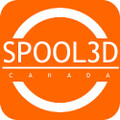3D Scanners
- Product
- Qty in Cart
- Quantity
- Price
- Subtotal
-
Out of stock

CR-Scan Ferret 3D Scanner
Creality
$459.00Free shipping in Canada for orders over $140 before tax. (via Canada Post) High quality at an affordable price Compact design with light weight only 105 grams Dual mode scanning including wide-range scanning and a high-accuracy mode Up to 30fps for...$459.00 -

Revopoint POP 3 Plus - Handheld 3D Scanner
$765.00 - $1,045.00Free shipping in Canada for orders over $140 before tax. Revopoint POP 3 Plus: The Handheld 3D Scanner with Color Scans Single-frame Accuracy Up to 0.08 mm Up to 18 fps Scanning Speeds Up to 2× Optical Zoom New Global Marker Tracking Mode HD...$765.00 - $1,045.00
Scanning Scenarios:
The MINI series is designed for professionals who want to scan smaller objects such as industrial parts, jewelry, small statues, etc., capturing precise detail.
The POP series is designed for professionals who want to scan medium-sized objects, such as engine parts or vases.
The RANGE series is designed for professionals who want to scan large objects such as furniture, people, and vehicles, ensuring efficient and thorough scanning results.
The INSPIRE is for hobbyists, 3D printing enthusiasts, and makers who want to scan medium-sized objects.
The MIRACO is an all-in-one scanning system that captures small to large objects.
| Revopoint 3D Scanner | Inspire | MINI 2 | POP 3 Plus | RANGE 2 | MIRACO | MIRACO PLUS | MetroX |
| $, Starting at | $649 | $1229 | $765 | $1079 | $1929 | $2670 | $1549 |
| Single Frame Accuracy, up to | 0.3mm | 0.05mm | 0.08mm | 0.3mm | 0.05mm | 0.04mm | 0.03mm |
| Single Frame Precision, up to | 0.2mm | 0.02mm | 0.04mm | 0.1mm | 0.02mm | 0.02mm | 0.01mm |
| Min Scan Volume | 50x50x50mm | 10x10x10mm | 20x20x20mm | 50x50x50mm | 10x10x10mm | 10x10x10mm | 10x10x10mm |
| Max Scan Volume | 1x1x1m | 500x500x500mm | 2x2x2m | 4x4x4m | 4x4x4m | 4x4x4m | 1x1x1m |
| Working Distance | 250-500mm | 120-250mm | 150-400mm | 400-1300mm | 100-1000mm | 100-1000mm | 200-400mm |
| Scanning Speed, up to | 18fps | 16fps | 18fps | 16fps | 15fps | 20fps |
Multi-line Blue Laser: 800,000 Points/s Full Field Blue Light: 7,000,000 Points/s |
| Scanning Environment |
Indoor Outdoor |
Indoor |
Indoor Outdoor |
Indoor Outdoor |
Indoor Outdoor |
Indoor Outdoor |
Indoor |
| Scanner Weight | 140g | 175g | 190g | 253g | 750g | 750g | |
| Tech |
Dual Camera Infrared Light |
Dual Camera Blue Light |
Dual Camera Infrared Light |
Dual Camera Infrared Light |
Quad Camera
Infrared Light |
Quad Camera Infrared Light Optical Zoom Ultra-resolution Photogrammetric Metrology |
Multi-line Laser Scan Full-field Structured Light Scan |
| Battery Capacity | n/a | n/a | n/a | n/a | 5000mAh | 5000mAh | n/a |
3D scanners are revolutionizing how we interact with the physical world. These innovative devices capture the shape and appearance of objects in three dimensions, transforming real-world objects into digital 3D models. This technology has applications across various industries, from manufacturing and healthcare to entertainment and art.
How 3D Scanners Work
3D scanners utilize various techniques to capture 3D data. Some common methods include:
- Structured Light: Projecting patterns of light onto an object and analyzing the distortions to determine its shape.
- Time-of-Flight: Measuring the time it takes for a laser pulse to travel to the object and back, determining distance.
- Photogrammetry: Capturing multiple images of an object from different angles and using software to reconstruct its 3D model.
Types of 3D Scanners
- Handheld Scanners: Portable and easy to use, ideal for scanning smaller objects.
- Desktop Scanners: Offer higher accuracy and resolution, suitable for scanning medium-sized objects.
- Industrial Scanners: Designed for high-precision scanning of large objects and complex surfaces.
Applications of 3D Scanning
- Manufacturing: Reverse engineering, quality control, rapid prototyping, and 3D printing.
- Healthcare: Creating custom prosthetics and implants, medical imaging, and surgical planning.
- Entertainment: Character modeling, special effects, and virtual reality.
- Art and Design: Creating digital sculptures, preserving historical artifacts, and customizing products.
- Archaeology: Documenting and preserving ancient artifacts.
Benefits of Using 3D Scanners
- Increased Efficiency: Streamline workflows and reduce production time.
- Improved Accuracy: Achieve precise measurements and capture intricate details.
- Reduced Costs: Minimize material waste and eliminate the need for physical prototypes.
- Enhanced Creativity: Unlock new possibilities for design and innovation.
The Future of 3D Scanning
3D scanning technology continues to evolve rapidly, with advancements in:
- Accuracy and Resolution: Capturing finer details with greater precision.
- Speed: Scanning objects faster and more efficiently.
- Portability: Developing smaller and more compact scanners.
- AI Integration: Utilizing AI for automated scanning and data processing.
3D scanners are powerful tools with a wide range of applications across various industries. As the technology continues to advance, we can expect to see even more innovative and exciting uses for 3D scanning in the future.
